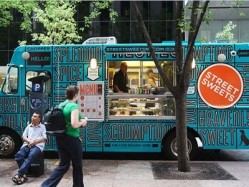Learning from abroad: Restaurants

To this end we took a look at what trends are taking off in other restaurant markets around the world to uncover some inspiration for UK operators to improve their business.
Food trucks
America
The popularity of mobile catering vans offering quality street food at low prices has soared in the US, prompting the launch of several weekly “Food Truck Fairs” in locations across the country.
On a daily basis, units selling a variety of foods, from pizzas and burgers to waffles, dumplings and grilled cheese sandwiches, roll up in high footfall, urban locations such as large business forecourts, schools and shopping districts for around 90 minutes over the lunch period before moving on. Operators change their locations daily so customers are given a choice of new concepts.
Due to the transient nature of their operation, the trucks rely heavily on social media to spread the word about where they’ll be pulling up next.
While the majority of these trucks are independently-operated single units, the big fast-casual players are beginning to latch on to the benefits of operating a chain of low-cost, high yield trucks across numerous locations. National brands such as Taco Bell and Dunkin Donuts have already begun rolling out food trucks, with KFC expected to follow suit.
Will it work in the UK?
While the concept itself is not exactly new over here, the phenomenon is by no means as enormous as in the US. Only a handful of operators are regularly running mobile catering vans and even then only really in the UK’s major business and tourism districts.
However the high footfall and relatively low start up and operating costs make food trucks a viable business option for restaurateurs looking to expand their existing concept, or even launch a new one. The popularity of social media in the UK will also help ensure new food trucks are marketed effectively. That said, operators will need to consider the regulations imposed by local authorities, particularly in built up, commercial areas.
With fast-casual chains like KFC expected to take advantage of the trend in the UK soon, now’s the time for operators to consider how mobility could boost their profitability.
Chinese cuisine
Sydney
Since the gold rush of the 1850s Australia has welcomed a high level of Chinese immigrants, and as such now boasts some of the best Cantonese cuisine outside of China.
However in recent years the cuisine has undergone a kind of renaissance, with a scope of fast-casual, regional Chinese cafes and restaurants cropping up, serving more focused cuisine such as Sichuan, Hunanese, Yunanese, Uighur and Xinjiang.
Will it work in the UK?
According to Allegra Strategies’ How Britain Eats 2010 report, Chinese food is the nation’s second favourite cuisine behind traditional British fare, and with diners becoming increasingly adventurous regional Chinese cuisine could take off in a big way.
However potential operators may find qualified, experienced chefs hard to come by, particularly with the government’s controversial immigration cap preventing new talent from reaching our shores.
Lunchtime innovator
Singapore
The Singaporean restaurant market is highly saturated and very competitive, particularly in the region’s central business district which is akin to the City of London. Since the region’s stock exchange abandoned its usual lunch break, forcing many traders to work throughout the entire day, midday trade has plummeted for restaurateurs with many forced to close at lunch altogether.
Those operators that chose to remain open during lunchtime have had to innovate to stand out from the crowd. Some tactics employed by restaurateurs include refreshing menus weekly rather than monthly or quarterly to attract repeat business; ensuring greater variety on menus; and discounting set menu prices to remain competitive.
Alternatively, some high-end restaurateurs have opted to concentrate solely on dinner, reducing the manpower and overheads costs associated with opening during the day, and upselling alcohol more in the evening to help make up for lost revenue.
Will it work in the UK?
Those restaurant owners in the UK that are feeling the lunchtime pinch could do well to learn from their Singaporean cousins. While refreshing menus more often can be costly in terms of development, regularly changing dishes is a great way to attract repeat visits from those diners that are able to eat out at lunchtime regularly. Closing your business entirely during the day is to be avoided where possible, unless your evening menu prices can compensate for lost lunchtime revenue.
You can view all the articles in this series by clicking here.























